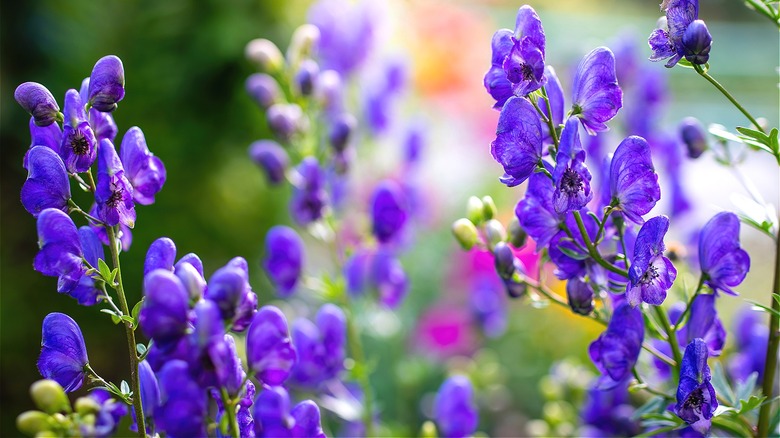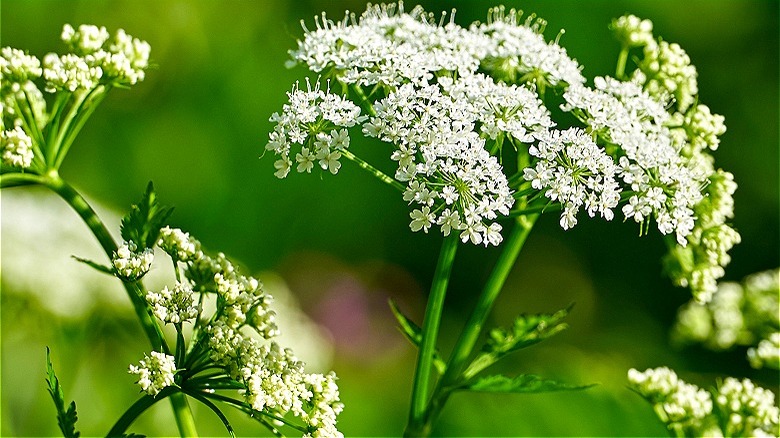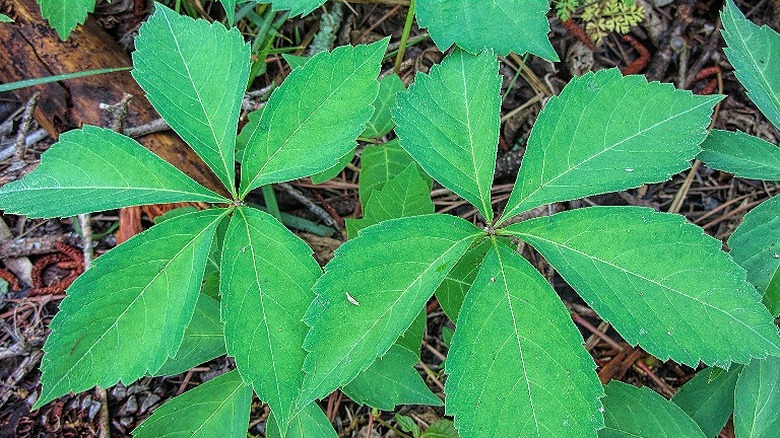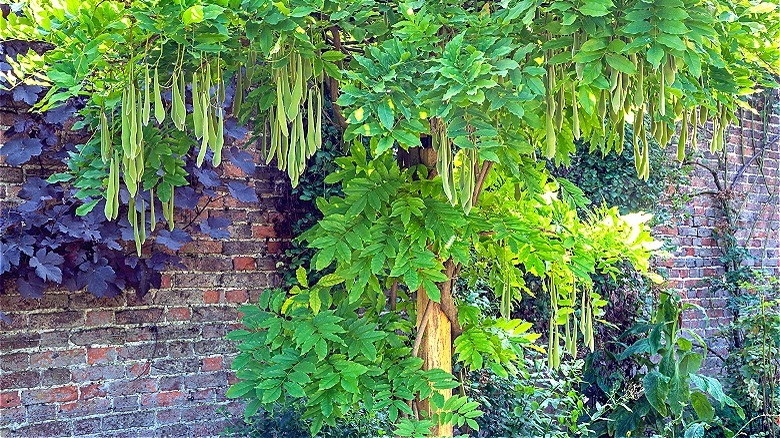Don't Mistake These 10 Poisonous Plants For Their Harmless Look-Alikes
Our world is filled with a variety of plants that range from delicate and delicious to downright dangerous. Navigating what's safe and what's not would be simple if all toxic or poisonous plants were easily identifiable. However, many plant species look very similar to other, sometimes completely unrelated, plant species. Learning to spot the difference is the best way to ensure you don't mistake poisonous plants for their harmless look-alikes.
Poison Control data for 2021 listed plants among the top 10 sources of poison exposure. If you know what plants to avoid, you'll know which plants are safe to eat, touch, and grow, which is especially helpful if you have children or pets. Ingesting poisonous plants can lead to gastrointestinal problems, breathing complications, and death, per the National Capital Poison Center. Other species, meanwhile, affect the skin, leaving burns and scars behind. To help you avoid such situations, we've compiled a list of 10 poisonous and toxic plants that look deceptively like harmless garden favorites.
1. Poison hemlock
If plants came with name tags, we'd know to immediately avoid poison hemlock (Cicuta maculata). However, its delicate appearance is inviting and reminiscent of baby's breath, a nontoxic filler flower often used in bouquets. Poison hemlock has small white flowers that grow in tiny clusters. The plant is toxic to humans when ingested and some cases have even been reported of it absorbing into someone's skin (via King County).
Bloom Season: Spring
USDA Growing Zone: 5 to 9
Growing Conditions: Full sun, partial shade
Soil Type: Slightly acidic soil
Size: 6 1/2 to 10 feet tall
2. Giant hogweed
Giant hogweed (Heracleum mantegazzianum), another white plant, has a similar structure to poison hemlock. Its flowers grow in clusters and form an umbrella-like structure that can tower over the average person. Giant hogweed has a sap, that when touched, can cause burns and permanent scarring. So it's critical to wear gloves if you need to remove hogweed from your yard.
Bloom Season: Summer (late June, early July)
USDA Growing Zone: 3 to 9
Growing Conditions: Partial shade
Soil Type: Acidic sandy, loamy, or clay soil
Size: 7 to 14 feet tall
3. Deadly nighsthade
The name "deadly nightshade" (Atropa belladona) is well-known, but its appearance can easily be mistaken for twinberry honeysuckle or even dark cherries. Though deadly nightshade's deep purple berries look like harmless fruits, they're fatal in even small amounts, according to The Wildlife Trusts. You can distinguish nightshade by its pointed oval-shaped leaves.
Bloom Season: June to September
USDA Growing Zone: 5 to 9
Growing Conditions: Full sun, partial shade
Soil Type: Limestone-rich soil
Size: 3 to 4 feet tall, 3 to 4 feet wide
4. Pokeweed
Pokeberries (Phytolacca americana) sound like a sweet treat, but they're deceptively enticing. According to Poison Control, it's not uncommon for children to confuse the plant's berries for grapes. Though they're not fatal, pokeberries cause gastrointestinal distress like nausea and vomiting. So it's best to remove pokeweed from your yard if you have small children.
Bloom Season: Year-round in Southern states, May to October in Northern states
USDA Growing Zone: 4 to 8
Growing Conditions: Full sun, partial shade
Soil Type: Loamy, sandy, or clay soil with an acidic, alkaline, or neutral pH
Size: 4 to 10 feet tall
5. Virginia creeper
At first glance, the Virginia creeper (Parthenocissus quinquefolia) looks like a simple vine, but like many other plants with spiky leaves, it's toxic. It grows berries that could look like blackberries to the untrained eye. Virginia creeper has a distinctive five-leaf structure that resembles poison oak, another plant you should avoid.
Bloom Season: Begins in July, and extends into fall
USDA Growing Zone: 3 to 10
Growing Conditions: Dappled sun, full sun, and partial shade
Soil Type: Loamy, sandy, or clay soil with an acidic, alkaline, or neutral pH
Size: 30 to 50 feet tall and 5 to 10 feet wide
6. Wisteria
Wisteria is a beautiful twining vine that produces light purple flowers. This fantastical-looking plant has poisonous seeds that grow in pods. Additionally, the entire plant is toxic if ingested. Symptoms range from dizziness to gastritis.
Bloom Season: Mid-spring
USDA Growing Zone: 5a, 5b, 6a, 6b, 7a, 7b, 8a, 8b, 9a, 9b
Growing Conditions: Full sun, partial shade
Soil Type: Well-draining, slightly acidic
Size: 10 to 25 feet tall
7. Carolina horsenettle
Carolina horsenettles (Solanum carolinense) are incredibly deceptive. Not only do they produce blooms that look like harmless wildflowers, they also grow a form of wild tomato. However, these tomatoes should be avoided at all costs. They and the rest of the horsenettle are poisonous.
Bloom Season: Summer and fall
USDA Growing Zone: 7a, 7b, 8a, 8b, 9a, 9b, 10a, 10b
Growing Conditions: Full sun
Soil Type: Loamy, sandy, or clay soil with an acidic, alkaline, or neutral pH
Size: Up to 4 feet tall
8. Death camas
Like poison hemlock, death camas (Zigadenus) was named as a warning. The entire plant is toxic and can cause serious illness when ingested. This is a problem as it can be mistaken for wild onion. According to the U.S. Forest Service, the best way to identify a death camas is to look for green or yellow glands at the base of the petals.
Bloom Season: Fall
USDA Growing Zone: 8a, 8b, 9a, 9b, 10a, 10b, 11a, 11b
Growing Conditions: Full sun, partial shade
Soil Type: Acidic sandy and rocky soil
Size: 2 to 3 feet tall, 2 to 3 feet wide
9. Wolfsbane
Wolfsbane (Aconitum), also called monkshood, is a poisonous plant that has gained a reputation through literature and history for its use as a poison. There are many species of wolfsbane and most of them can cause respiratory paralysis and heart failure, per Poison Control. While some florists have managed to cultivate nontoxic varieties, it's best to leave these flowers in the wild.
Bloom Season: Fall
USDA Growing Zone: 3 to 7
Growing Conditions: Full sun, partial shade
Soil Type: Loamy or clay soil with an acidic, alkaline, or neutral pH
Size: 3-4 feet tall, 1 to 1/2 feet wide
10. American bittwersweet
American bittersweet (Celastrus scandens) can be used as a seasonal decoration, but don't eat the berries no matter how juicy (and harmless) they may look. The berries of an American bittersweet, classified as low toxicity, are known to cause stomach upset and vomiting (via the Lady Bird Johnson Wildflower Center).
Bloom Season: Year-round
USDA Growing Zone: 3 to 8
Growing Conditions: Dappled sunlight or full sun
Soil Type: Alkaline soil
Size: 20 to 25 feet tall, 2 to 8 feet wide










